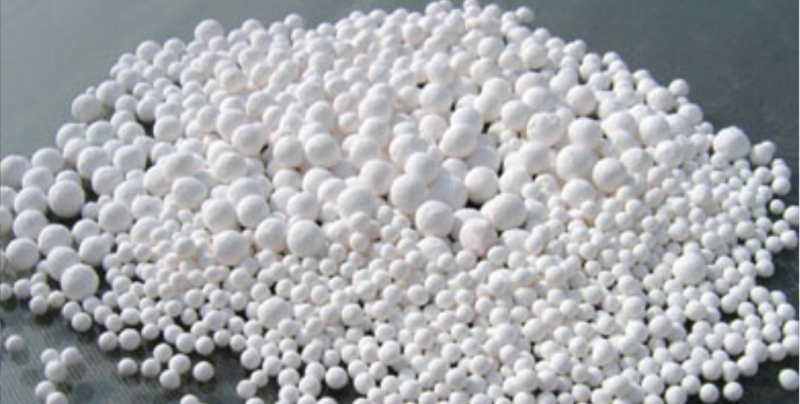News
Activated alumina desiccant flocculant, coagulant, coagulant aid what is the difference between?

Activated alumina product Profile:
Activated alumina is made of high purity alumina by scientific deployment and catalytic finishing. It can absorb and remove fluorine harmful to human body in water, and can be used for drinking water and industrial equipment of deoxygenation, fluoride, arsenic, sewage decolorization, deodorization and so on.
Activated alumina product details:
Activated alumina has many pores and large surface area, which can be used as adsorbent, desiccant and catalyst. At the same time, according to the strength of the polarity of the adsorption material to determine, water, oxide, acetic acid, alkali, has a strong affinity, is a micro water depth desiccant, adsorption of polar molecules adsorbent. Activated alumina is similar to anion exchange resin in fluorine removal, but the selectivity of fluorine ion anion resin is large. Activated alumina adsorption defluorination effect is good, stable capacity, per cubic meter of activated alumina fluorine absorption 6400 grams. This product has high strength, low wear, water immersion invariable soft, no expansion, no powder, no rupture. It can be widely used for deep drying of petroleum cracking gas, ethylene propylene gas and hydrogen production, air separation device, drying instrument air dryer, fluoride treatment in hydrogen peroxide can also remove sulfur hydrogen gas, sulfur dioxide, hydrogen fluoride, hydrocarbons and other pollutants in the exhaust gas, especially for the defluorination treatment of fluorinated water.
Application range of activated alumina:
1, air, natural gas, oil cracking gas drying dehydration
2, drinking water fluoride
3. Special catalyst for the production of hydrogen peroxide by cinerquinone method
4, viscous resin dechlorination
5. Catalyst carrier
6, air separation and oxygen industry
1. Definition of flocculation and classification of flocculants
Flocculation is a process in which the polymer chain Bridges between suspended particles. "Bridging" refers to the adsorption of different chain segments on different particles to promote the aggregation of particles. Most of the flocculants are polymers and have specific electrical (ionic) and charge density (ionicity). Flocculant is generally divided into organic flocculant and organic flocculant. Inorganic flocculants are ferrous sulfate, ferrous chloride, alum, polyaluminum chloride, basic aluminum chloride, aluminum sulfate, calcium chloride, etc. Organic flocculation is not mainly polymer flocculant, currently used more is polyacrylic acid sodium, polyacrylamide, polystyrene sulfonate, polyoxyethylene and so on.
Two, the principle of coagulation coagulant categories of suspended particles in water when the particle size is small to a certain extent, the energy of Brownian motion is enough to prevent the effect of gravity, and the particles do not settle. This suspension can remain stable for a long time. Moreover, the surface of suspended particles is often charged (often negatively charged), and the repulsion of the same charge between particles makes it difficult for particles to merge and become larger, thus increasing the stability of suspension. The coagulation process is to add a positively charged coagulant to neutralize the negative charge on the surface of the particle, so that the particle is "de-stabilized". As a result, through collisions, surface adsorption, van der Waals attraction and other actions, the particles combine with each other to become larger, in order to facilitate separation from water. Coagulants are water-soluble polymers with low molecular weight and high positive charge density, most of which are liquid. They fall into two main categories, inorganic and organic. Inorganic coagulants are mainly aluminum, iron salt and their polymers.
Three, action mechanism and classification of coagulant aid coagulant aid is to improve or enhance the coagulation process and adding some auxiliary agents, its action principle is associated with specific purposes, in the case of algae bloom, can undertake preoxidation oxidizing agent to improve the effect of coagulation, also can add organic high polymer coagulant aid, increase floc density, improve the effect of coagulation precipitation; For low temperature and low turbidity water treatment, due to its high viscosity, the flocculant settlement performance is poor, resulting in the increase of coagulant dosage, at this time, adding organic or inorganic polymer coagulant aid to increase the size of the flocculant, increase the density of the flocculant, improve the sedimentation rate; For raw water with low basicity, the coagulation process will lead to pH decline, which will not only affect the coagulation effect, but also produce acidic water, which is not conducive to the stability of water quality of pipe network, so it is necessary to add alkali for pH adjustment; For organic chromaticity water, not only the dosage of coagulant increases, but also the sedimentation performance deteriorates. A certain amount of organic polymer coagulant aid can be added to improve the sedimentation performance, and a certain amount of oxidizer can be added to destroy the stability of organic matter on colloid. For the wastewater containing iron and manganese, oxidant can destroy the organic complex of iron and manganese, which is beneficial to the removal of iron, manganese and organic matter in the water.
Type of coagulant: organic and inorganic polymer, such as activated silicic acid, polyacrylamide, bone glue, etc. ⒉pH regulator such as hydrochloric acid, sulfuric acid and alkali lime. ⒊ inorganic particles such as clay and microsand. Tom oxidant, such as potassium permanganate, chlorine dioxide, etc. in practical use because coagulant/flocculant/coagulant aid are macromolecule material, large and small molecules in the same product have, the so-called "molecular weight" is just an average concept. Therefore, in the treatment of wastewater with a coagulant or flocculant, "electrical neutralization" and "bridging" will be intertwined. The flocculation process is the result of many factors. There are still some problems that have not been recognized and solved at present. As far as we know, the flocculation process is related to the molecular structure, charge density and molecular weight of the flocculant. It is related to the surface properties, particle concentration and specific surface area of suspended particles. And the medium (water) pH value, conductivity, the presence of other substances in the water, water temperature, agitation and other factors. So although there are theories and experience to follow, it is still necessary to choose flocculant by experiment.
Welcome to contact:+8618013418091(Whatsapp/Wechat)
+8618013418097(Whatsapp/Wechat)
 Alvin
Alvin hugh778
hugh778